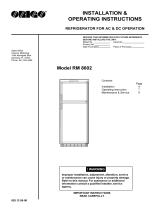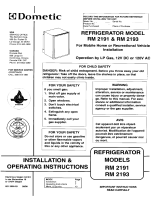Dometic RM2812 is a refrigerator designed for storage of foods and storage of frozen foods and making ice. It has been design certified by A.G.A. under ANSI Z21.19 Refrigerator Standard for installation in a mobile home or recreational vehicle and are approved by the Canadian Gas Association. The refrigerator requires one roof vent and one lower side vent for proper installation. It must be electrically grounded in accordance with the National Electric Code ANSI/NFPA 70 when installed if an external alternating current electrical source is utilized.
Dometic RM2812 is a refrigerator designed for storage of foods and storage of frozen foods and making ice. It has been design certified by A.G.A. under ANSI Z21.19 Refrigerator Standard for installation in a mobile home or recreational vehicle and are approved by the Canadian Gas Association. The refrigerator requires one roof vent and one lower side vent for proper installation. It must be electrically grounded in accordance with the National Electric Code ANSI/NFPA 70 when installed if an external alternating current electrical source is utilized.












-
 1
1
-
 2
2
-
 3
3
-
 4
4
-
 5
5
-
 6
6
-
 7
7
-
 8
8
-
 9
9
-
 10
10
-
 11
11
-
 12
12
Dometic RM2812 is a refrigerator designed for storage of foods and storage of frozen foods and making ice. It has been design certified by A.G.A. under ANSI Z21.19 Refrigerator Standard for installation in a mobile home or recreational vehicle and are approved by the Canadian Gas Association. The refrigerator requires one roof vent and one lower side vent for proper installation. It must be electrically grounded in accordance with the National Electric Code ANSI/NFPA 70 when installed if an external alternating current electrical source is utilized.
Ask a question and I''ll find the answer in the document
Finding information in a document is now easier with AI
Related papers
-
Dometic Refrigerator Elite RM7732 User manual
-
Dometic NDR1062 User manual
-
Dometic NDR1062 User manual
-
Dometic RM2820 User manual
-
Dometic RM2820 User manual
-
Dometic RM2652 User manual
-
Dometic RM2652 User manual
-
Dometic RM2652 User manual
-
Domestic RM 2620 Operating instructions
-
Dometic RM2454 User manual
Other documents
-
Hasbro Koosh Bubble Whistle Operating instructions
-
Electrolux RM2330 User manual
-
 ORIGO RM8602 User manual
ORIGO RM8602 User manual
-
Norcold N1095 Installation guide
-
Norcold N1095 Installation guide
-
Norcold 604M.3 Installation guide
-
Norcold N614E Installation guide
-
Norcold 121X series Installation guide
-
 Dometic (N-DC) RM2193 User manual
Dometic (N-DC) RM2193 User manual
-
Atwood HE-0801 User manual













